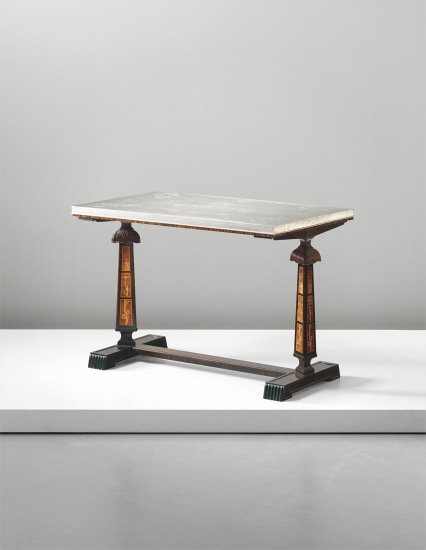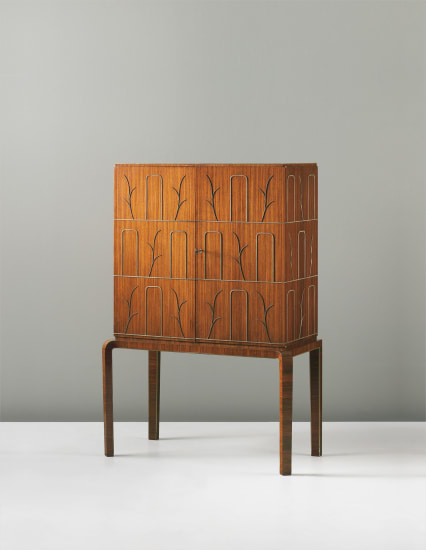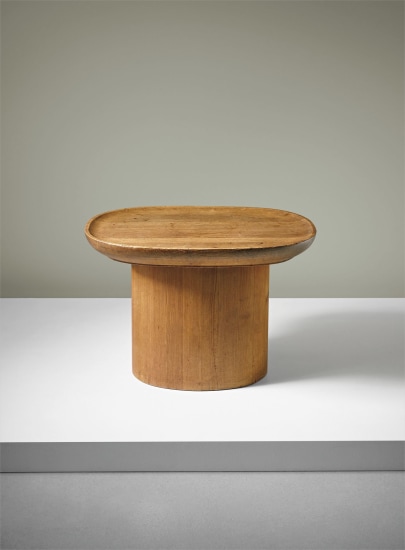Axel Einar Hjorth and Nils Fougstedt 'Caesar' table, designed for the International Exhibition, Barcelona designed 1928, produced 1930 Engraved pewter, stained birch. 62.7 x 77.8 x 43.8 cm (24 5/8 x 30 5/8 x 17 1/4 in.) Produced by AB Nordiska Kompaniet for Svenskt Tenn, Stockholm, Sweden. Underside with manufacturer's metal labels impressed A•B•NORDISKA KOMPANIET STOCKHOLM and other impressed NK R 33243 - C 11 10 30. Tabletop marked with manufacturer's mark Svenskt Tenn, Stockholm city mark, date mark D8.
Literature Nils G. Wollen, ed., Svenska Slöjdföreningens Tidskrift: Organ För Konstindustri Handverk Och Hemslöjd, vol. XXV, 1929, p. 55 Christian Björk, Thomas Ekström and Eric Ericson, Axel Einar Hjorth: Möbelarkitekt, Stockholm, 2009, pp. 76-77, 111 Catalogue Essay The architect Axel Einar Hjorth is considered an important proponent and creator of Swedish Grace and his contribution to Swedish furniture design during the interwar period is highly regarded. Axel Einar Hjorth, aged 12, was adopted by a bourgeois family. All the unfortunate hardships that his mother attempted to endure for the sake of her son were alas unendurable. Upon being adopted Hjorth was inculcated and quickly assimilated within his newly acquainted social environment. In 1908, aged 20, Hjorth arrived in Stockholm to study at the Högre Konstindustriella Skolan, now the Konstfack, University College of Arts, Crafts and Design. Again Hjorth's circumstances changed, his adopted father passed and he was left with no inheritance in order to pursue his studies in Stockholm. Inevitably his academic pursuits ended, leaving him with no other option than to work. Six years after his arrival in Stockholm Hjorth married and again became placed amongst the bourgeoisie. In 1923, Hjorth was the assembly head for the Gothenburg Exhibition. P. Morton Shand, the architectural critic, co-founder of Finmar and editor of the British periodical The Architectural Review writes the following: ‘The Gothenburg Exhibition of 1923 revealed Sweden to an astonished world, not merely as an ‘artistic’ nation, but as almost the only one that really counted as far as design and craftsmanship were concerned’ (P. Morton Shand, ‘Stockholm, 1930’, The Architectural Review, vol. LXVIII, July-December 1930, p. 67). International praise from such a stalwart of modern design reflects the quality of the work exhibited, a majority of which was realised by the architect Axel Einar Hjorth. Read More
Axel Einar Hjorth and Nils Fougstedt 'Caesar' table, designed for the International Exhibition, Barcelona designed 1928, produced 1930 Engraved pewter, stained birch. 62.7 x 77.8 x 43.8 cm (24 5/8 x 30 5/8 x 17 1/4 in.) Produced by AB Nordiska Kompaniet for Svenskt Tenn, Stockholm, Sweden. Underside with manufacturer's metal labels impressed A•B•NORDISKA KOMPANIET STOCKHOLM and other impressed NK R 33243 - C 11 10 30. Tabletop marked with manufacturer's mark Svenskt Tenn, Stockholm city mark, date mark D8.
Literature Nils G. Wollen, ed., Svenska Slöjdföreningens Tidskrift: Organ För Konstindustri Handverk Och Hemslöjd, vol. XXV, 1929, p. 55 Christian Björk, Thomas Ekström and Eric Ericson, Axel Einar Hjorth: Möbelarkitekt, Stockholm, 2009, pp. 76-77, 111 Catalogue Essay The architect Axel Einar Hjorth is considered an important proponent and creator of Swedish Grace and his contribution to Swedish furniture design during the interwar period is highly regarded. Axel Einar Hjorth, aged 12, was adopted by a bourgeois family. All the unfortunate hardships that his mother attempted to endure for the sake of her son were alas unendurable. Upon being adopted Hjorth was inculcated and quickly assimilated within his newly acquainted social environment. In 1908, aged 20, Hjorth arrived in Stockholm to study at the Högre Konstindustriella Skolan, now the Konstfack, University College of Arts, Crafts and Design. Again Hjorth's circumstances changed, his adopted father passed and he was left with no inheritance in order to pursue his studies in Stockholm. Inevitably his academic pursuits ended, leaving him with no other option than to work. Six years after his arrival in Stockholm Hjorth married and again became placed amongst the bourgeoisie. In 1923, Hjorth was the assembly head for the Gothenburg Exhibition. P. Morton Shand, the architectural critic, co-founder of Finmar and editor of the British periodical The Architectural Review writes the following: ‘The Gothenburg Exhibition of 1923 revealed Sweden to an astonished world, not merely as an ‘artistic’ nation, but as almost the only one that really counted as far as design and craftsmanship were concerned’ (P. Morton Shand, ‘Stockholm, 1930’, The Architectural Review, vol. LXVIII, July-December 1930, p. 67). International praise from such a stalwart of modern design reflects the quality of the work exhibited, a majority of which was realised by the architect Axel Einar Hjorth. Read More












Try LotSearch and its premium features for 7 days - without any costs!
Be notified automatically about new items in upcoming auctions.
Create an alert